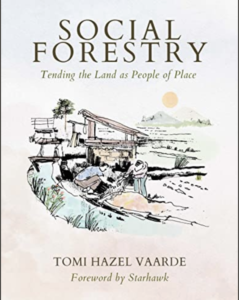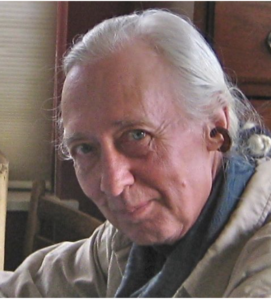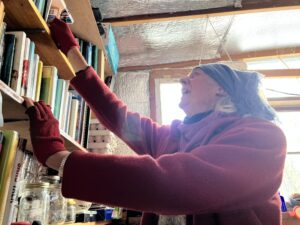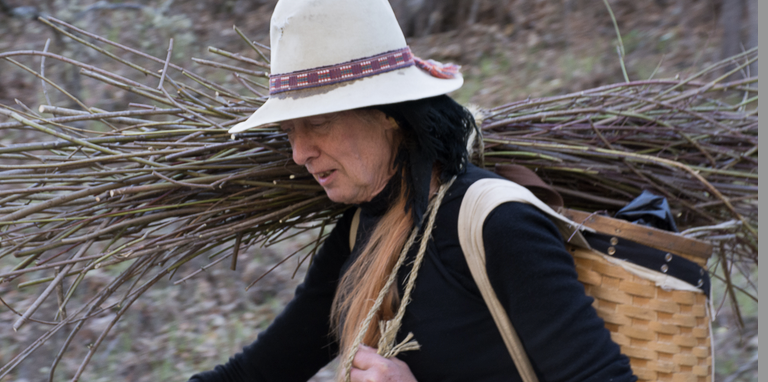How do we become ‘People of Place’?
by Christina Ammon
If forest restoration was an engineering problem Tomi Hazel Vaarde’s new book could’ve been titled, Three Ways to Heal the Land: Salmon, Beaver, Fire. It might have made for a breezier read. It also wouldn’t have been as fascinating—or honored the breadth and depth of the task. Instead, Hazel’s 512-page opus is titled Social Forestry: Tending the Land as People of Place (Synergetic Press). While the book does include plenty of practical advice, it does so in the context of something decidedly unstraightforward: Reconnecting people to place. This “rewilding” is at the heart of the Social Forestry idea.

Hazel’s new book can be purchased through the Siskyou Permaculture website (link at the end of article).
At a time when it seems like the best thing we can do for nature is leave it alone, Hazel’s book urges the opposite. Human disturbances can be good—essential even–so long as they are ecologically appropriate, balanced, and reciprocal. A practice like well-timed coppicing (cutting) enhances biodiversity while supplying construction materials for baskets, fences and homes. Same goes for intentional burning: It produces charcoal and enriches the soil, while reducing the risk of catastrophic fire.
“The forests, woodlands, prairies, brush fields, stream sides and ridgelines miss us,” Hazel writes.
The book includes plenty of similar “small scale advice,” but ultimately Hazel cautions that Social Forestry does not translate well into tips. That’s the reason behind this trove of prose, posters and poems that draw on a lifetime of learning—first, as a Quaker child set loose in the woods near the Adirondacks, then as a student of forestry and botany, and later an environmental educator at colleges and institutes. The book is also a gathering of Indigenous wisdom gleaned from her world travels.
While re-wilding can’t be approached academically,” the hallmarks of good Social Forestry are that its site specific, collaborative, and responsive to the landscape’s feedback. Practically, this looks like people tending to their neighborhood drainage basins in accordance to the needs of the land.
“Let the land guide us,” she writes.
Listening to the Land
Hazel lives on an oak savannah woodland known as Wolf Gulch in Southern Oregon’s Applegate Valley. Each winter, students stay at Wolf Gulch for a week of Social

Hazel has been a permaculture educator at Evergreen State College and taught Wild Edibles & Woodslore at Laney College.
Forestry experience. While there, they pursue a deeply local curriculum of forest bathing, trail-making, ceremonies, basket-weaving and, if the conditions are right, cool-burning. The activities are carried out with hand tools and informed by the needs of the land that Hazel has spent two decades observing. The goal is that the students leave with an expanded sense of connection with the woodlands, each other and themselves.
In her two decades observing the Applegate, Hazel has concluded that the return of beaver, salmon and fire are essential to restoring watershed health. She acknowledges that the urban-wildland interface of the valley has been “hammered” by decades of mining, logging, poor farming practices, but in certain ways it’s way ahead. This is thanks
to the Back-to-the-Landers who set up nonprofit networks—like the Southwest Oregon Herb Association– in the 70s. Also, the valley’s complex topography also has a protective effect. The small finicky nooks and valleys foil attempts at industrial-scaling. It’s a landscape better suited to hubs and cooperatives.
If extractive industries can’t be scaled easily in the valley—neither can solutions. Hazel participates in the Applegate Watershed Council, but feels even that is too broad an effort for the “wild mosaic of complexity” that defines the surrounding Siskiyou Mountains. Ideally, there would be dozens of councils, each tending to their own drainage basins as site specifically as possible. “This is a multi-generational project,” she writes.
Is Hazel optimistic or pessimistic about the future?
“Curious,” she says.
Regaining Fluency

Hazel’s office is a warren of books nested in the Wolf Gulch forest. “I have time to read and write becauseI live below the poverty line,” she explains. “It’s called voluntary simplicity.” Her current read? Figleafing Through Time: A History of Clothing).
If you are craving a bulleted treatise of solutions, Social Forestry: Tending the Land as People of Place isn’t it. It is a circuitous read and is even prefaced by a section called “How to Read Hazel,’ written by Megan Fehrman. Referring to the author as a “trickster auntie”, she writes: “Reading Hazel is much like having a conversation with Hazel. A long, sometimes rambling, conversation that goes on for hours. Days. Years. But don’t worry, it all comes back around and begins to make sense.”
It does make sense. Afterall, traditional ecological knowledge has normally been passed down through riddles, songs, storytelling and chants. While these more indigenous mediums may frustrate our modern, narrative-driven minds, Hazel is confident that even the most displaced among us will catch on– it’s just a matter of regaining our lost fluency. So, if you’re reading the book and this Trickster Auntie seems to be getting lost in the narrative weeds, hang tight: She’s actually breaking trail.
To buy Hazel’s book, click here.


